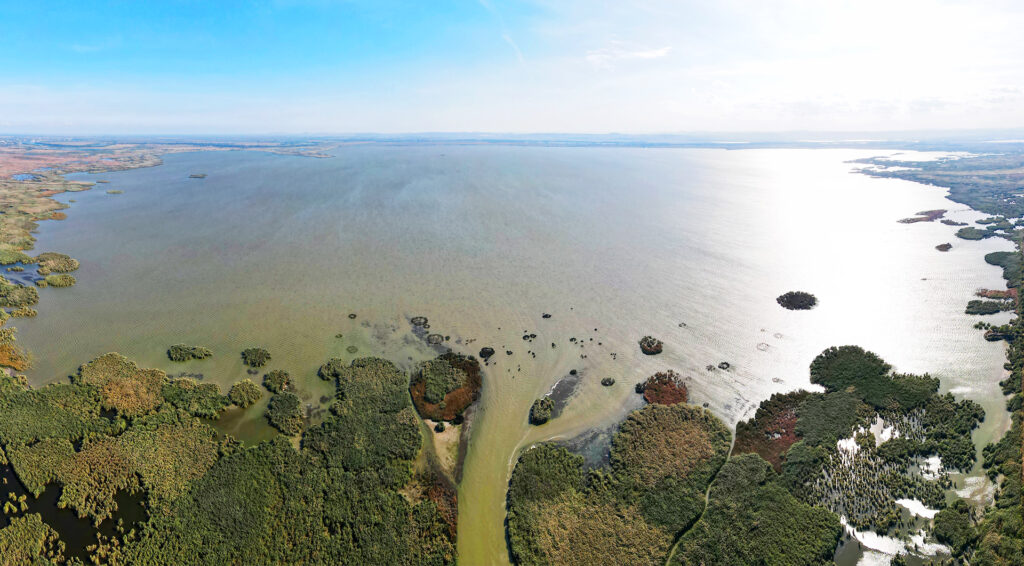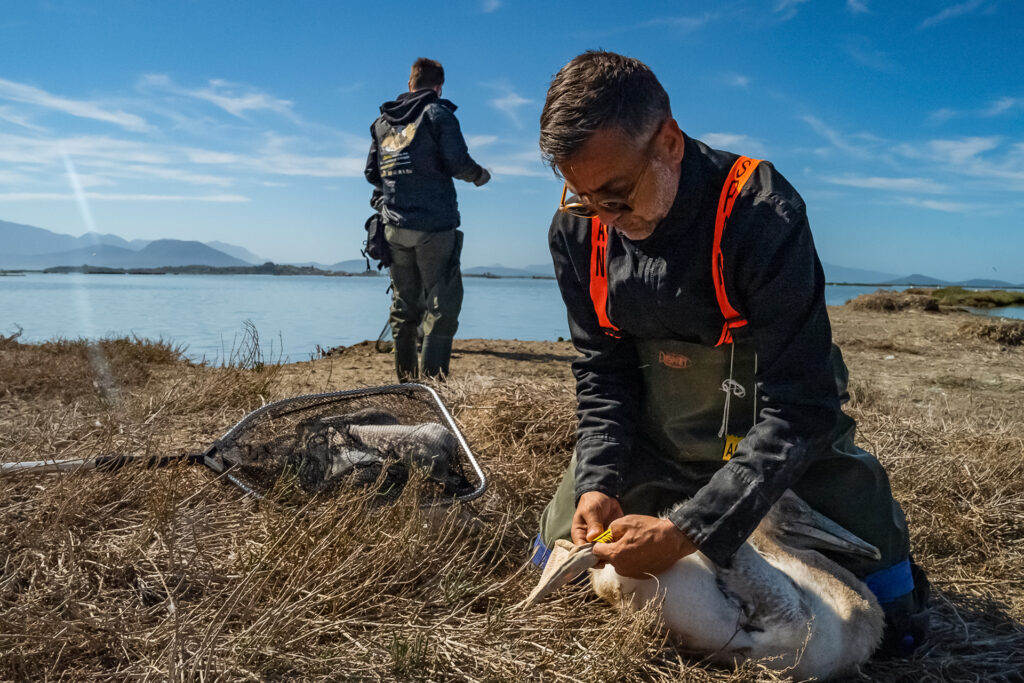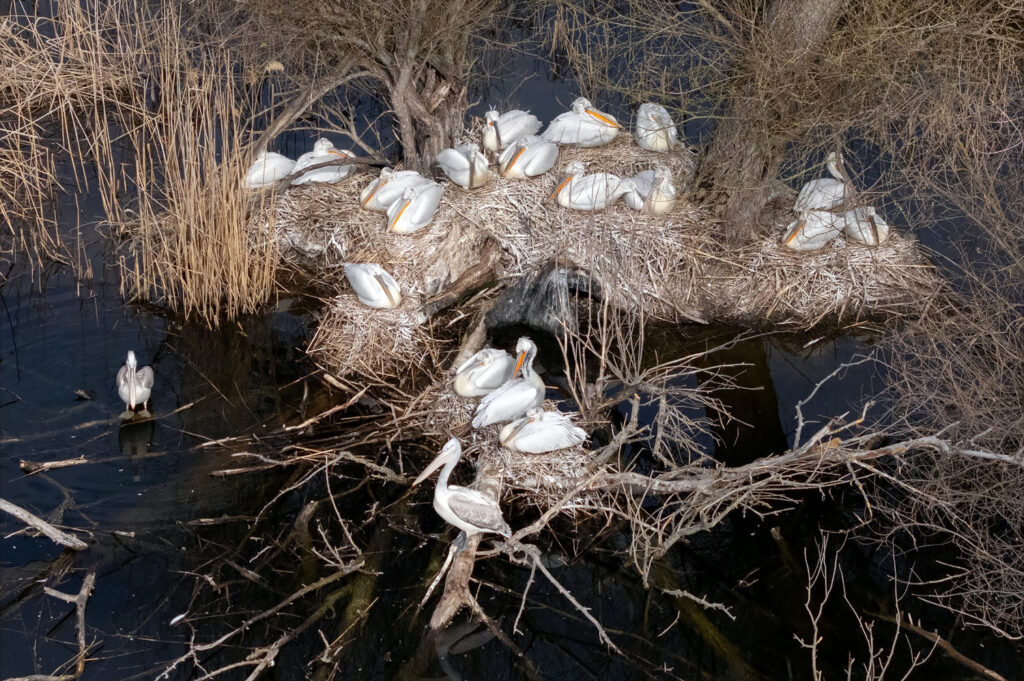Synthetic nesting platforms are supporting the continued restoration of European Dalmatian pelican populations within the Danube Delta and past.
Neil Aldridge / Rewilding Europe
An endangered icon
The long-lasting Dalmatian pelican is a globally threatened species, with an estimated worldwide inhabitants of lower than 20,000 people. Extraordinarily susceptible throughout its total geographical vary, the species has suffered a dramatic decline over current many years, with the principal causes together with collisions with energy traces, habitat loss, disturbance, direct persecution by fishermen, and a lack of know-how amongst native communities, in addition to avian flu. These threats, mixed with an absence of scientific information, make the way forward for the Dalmatian pelican closely reliant on conservation motion.
Coordinated by Rewilding Europe, the Pelican Approach of LIFE initiative kicked off in late 2019, with the goal of enhancing populations of the Dalmatian pelican in southwest Europe – together with within the Danube Delta, one of many strongholds of the species. Companions within the initiative have been working to cut back the threats to the birds and enhance their habitat at 27 websites throughout Romania, Bulgaria, Greece and Ukraine, in addition to finishing up capability constructing and analysis in Turkey, Albania, Montenegro, and North Macedonia.

Jeroen Helmer / ARK Rewilding Nederland
A serving to hand
Breeding websites of Dalmatian pelicans throughout the Balkans can include wherever between one and 250 nests, that are sometimes made from sticks, stones, mud, reeds, grasses, and feathers. Most colonies are situated in open or barely hid areas, and comprise between 10 and 20 nests.
With pure Dalmatian pelican nesting websites more and more broken by storms, swamped by flooding, or disturbed by human exercise, giving the birds a serving to hand by offering safe nesting platforms which might be largely inaccessible to predators has confirmed to be a extremely efficient technique for supporting inhabitants restoration. Platforms which were constructed in Bulgaria as a part of the Pelican Approach of LIFE initiative helped Dalmatian pelicans have a profitable breeding season in 2023.

Andriy Nekrasov / Rewilding Europe
Platform progress
The Pelican Approach of LIFE initiative has additionally seen the Rewilding Ukraine workforce assemble quite a lot of synthetic nesting platforms in several places throughout the Ukrainian a part of the Danube Delta rewilding panorama over the previous few years. The workforce have been unable to verify the standing of a number of of those platforms due to the continued warfare – on considered one of them, nonetheless, pelicans have been seen roosting.
To additional support Dalmatian pelican inhabitants restoration, one new platform has simply been constructed on 3500-hectare Ermakiv Island within the Danube Biosphere Reserve. The work was carried out by the Izmail Division of Water Sources, with which the Rewilding Ukraine workforce has collaborated on sensible rewilding efforts for a few years. The platforms have been coated in reeds and dummy pelicans put in, which ought to appeal to actual pelicans to the constructions.
As is the case in different nations, the goal is to encourage the birds to breed and thereby help the comeback of those mild giants. The platforms, which mimic islands with vegetation, function short-term nesting websites till broader wetland restoration can happen. Round 80% of European wetlands have disappeared over the past century, whereas people who stay are largely degraded resulting from human pressures and extremely susceptible to local weather change.
In direction of breeding success
Whereas extra Dalmatian pelicans seem like wintering within the Danube Delta, it has been a few years because the species has efficiently nested within the Ukrainian half. Just a few years in the past, Ukrainian ornithologists recorded a number of nests of Dalmatian pelicans on Lake Kugurlui, however a steady nesting colony didn’t develop.
“The birds now have to get used to the newest platform that has been constructed,” says Rewilding Ukraine communications officer Kateryna Kurakina. “We hope that they may firstly begin roosting on it, after which construct nests and lift chicks. All of us have our fingers crossed that this occurs on all of the platforms we have now constructed.”

Andriy Nekrasov / Rewilding Europe
Bouncing again
Sadly, 2022 was not a very good 12 months for Dalmatian pelicans in Europe. A significant outbreak of avian influenza – a extremely contagious viral illness that happens primarily in poultry and wild waterbirds – severely affected nesting colonies of the species within the Balkans and Romania. Greece, for instance, misplaced nearly 40% of its complete Dalmatian pelican inhabitants, whereas circumstances of excessive mortality have been additionally recorded in Albania and Montenegro.
Fortunately, 2023 was a much more beneficial 12 months, with many Dalmatian pelican populations exhibiting welcome indicators of restoration. A breeding colony of Dalmatian pelicans shaped within the Kalimok-Brushlen Protected Space close to Tutrakan in 2021 had an exceptionally profitable and record-breaking season, with 79 pairs efficiently raised 107 younger pelicans. In Persina Nature Park, 39 pairs efficiently raised 54 chicks. Total, in Bulgaria in 2023, a complete of 128 pairs of Dalmatian pelicans nested, efficiently elevating 176 chicks. This mirrored optimistic developments in different nations.

Natalie Clements / Rewilding Europe
“In Bulgaria we have now seen Dalmatian pelicans not solely crowding onto platforms to nest, but in addition onto fallen timber, so it’s clear that the birds actually lack appropriate areas for constructing nests,” says Kateryna Kurakina. “This highlights the worth of those platforms, and the truth that we have to proceed efforts to assist the birds nest – each by way of platforms, and habitat restoration.”
A global census of wintering Dalmatian pelicans occurred on the Balkan Peninsula in late November and mid-December as a part of the Pelican Approach of LIFE initiative, to gather information on the quantity and distribution of the birds throughout the area. In Romania, a complete of 949 people have been counted, comprising 704 adults and 245 immature birds. That is the best variety of Dalmatian pelicans recorded in Romania throughout winter monitoring because the begin of the initiative. Though a partial census was carried out within the Ukrainian a part of the Danube Delta, the continued warfare meant a complete depend was not possible.

Damyan Petkov / BSPB
The larger rewilding image
The susceptible Dalmatian pelican is without doubt one of the Danube Delta’s most iconic indicator species. This majestic hen requires entry to nonetheless, fish-filled waters undisturbed by human exercise, with intensive flooded and shallow water areas. Pelican populations within the delta have been hit laborious by the development of a life-sapping internet of dykes and agricultural polders between the Fifties and Eighties, which disconnected large swathes of floodplain from the Danube’s essential channels and lakes. This decimated fish shares and impaired the flexibility of the river to offer water for consuming and irrigation, and to mitigate flooding.
To reverse a few of the environmental injury, the Rewilding Ukraine workforce have been working laborious to revive the pure movement of water within the Ukrainian a part of the delta for the previous few years. Their ongoing efforts, that are more and more respiratory new life into huge swathes of wetland habitat, will profit each Dalmatian pelicans and other people.
The Pelican Approach of LIFE initiative is coordinated by Rewilding Europe and funded by the LIFE Programme of the European Union and the Arcadia Fund. In Ukraine, Pelican Approach of LIFE efforts are carried out by Rewilding Ukraine and the Danube Biosphere Reserve, along with different native companions. Constructing engagement is crucial to the success of pelican conservation measures, with Rewilding Europe organising an academic camp in June 2023 to attach schoolchildren from Ukraine, Romania, Greece, and Bulgaria with the birds.


















